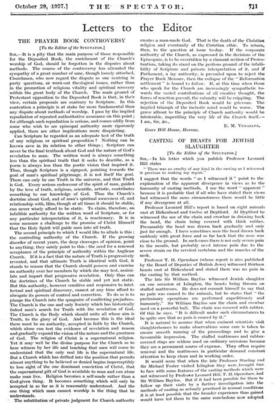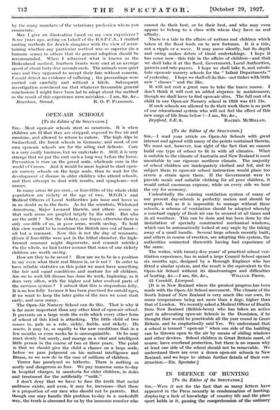CASTING OF BEASTS FOR JEWISH SLAUGHTER [To the Editor of
the SPECTATOR.] SIR,—In his letter which you publish Professor Leonard Hill states
" There was no cruelty of any kind in tho casting as I witnessed it previous to making my report."
I suggest that the words " as I witnessed it " point to the explanation of the apparent divergence in views as , to the humanity of casting methods. I use the word " apparent " because it is probable that if all who have stated their views had witnessed the same circumstances there would be little if any divergence at all.
Professor Leonard Hill's report is based on eight animals cast at Birkenhead and twelve at Deptford. At Deptford he witnessed the use of the chain and crowbar in dra.wing back the head, the chain being covered with thick rubber. Presumably the head was drawn back gradually and only just far enough. I have sometimes seen the head drawn back suddenly with great force and so far back that the nose was close to the ground. In such cases there is not only severe pain to the mouth, but probably most .intense pain due to the severe strain on the cervical vertebrae and the muscles of the neck.
Professor T. H. Openshaw (whose report is also published by the Board of Deputies of British Jews) witnessed thirteen beasts cast at Birkenhead and stated there was no pain in the casting by that method.
The late Sir William Bayliss witnessed Jewish slaughter on one occasion at Islington, the beasts being thrown on stuffed mattresses. He does not commit himself to say that no pain was caused to the animals, but he states that " the preliminary operations are performed expeditiously and humanely." Sir William Bayliss saw the chain and crowbar used on a powerful bull. The chain was covered with rubber. Of this he says, " It is difficult under such circumstances to be quite sure that no pain is caused by it."
It is natural to assume that when eminent scientists visit slaughterhouses to make observations some care is taken to ensure smooth running of the proceedings and to give a favourable impression. The stuffed mattresses and rubber- covered rings are seldom used on ordinary occasions because they are a permanent source of expense. They often require renewal and the mattresses in particular demand constant attention to keep clean and in working order.
It would seem that when the late Professor Starling and Sir Michael Foster visited Islington they were _brought face to face with some features of the casting methods which were
not witnessed by Professor Leonard Hill, T. H. Openshaw, and Sir William -Bayliss. But if it had been possible for them to follow up their visits by a further investigation into the methods of casting as actually practised in normal conditions it is at least possible that the broader experience thus gained . would have led them to the same conclusions now adopted
by the many members of the veterinary profession whcm you enumerate. • May I give an illustration based on my cwn experience ? Some years ago, acting on behalf of the R.S.P.C.A., I studied tasting methods for Jewish slaughter with the view of ascer- taining whether any particular method was so superior (in a humane sense) to others that its general adoption should be recommended. When I witnessed what is known as the Birkenhead method, fourteen beasts were cast at an average speed of about forty-five seconds each. The animals were quiet ones and they appeared to accept their fate without concern. I could detect no evidence of suffering ; the proceedings were carried out carefully and without a hitch. Subsequent investigation convinced me that whatever favourable general conclusions I might have been led to adopt about the method as the result of this experience were mistaken.—I am, Sir, &c.,



























































 Previous page
Previous page